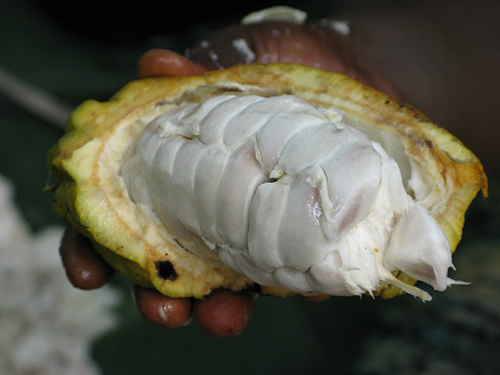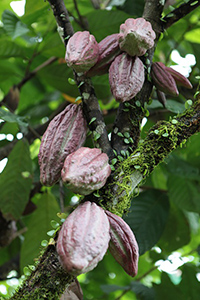Contents
These people drink a dark beverage made with the cacao plant, which they say comes from Paradise.
A Spanish soldier said in astonishment to his captain Hernan Cortes
I want to taste that beverage. Bring me a jar!
Said the Spanish captain
With drops of pocho-cacaua-atl (“beverage of cocoa and ceiba” in Aztec language) running down his lips, which became dyed in dark brown, Hernan Cortes said to a group of his soldiers, who were attentively watching him:
It tastes mildly sour, but it is refreshing and tasteful.
Hernan Cortes
Soon after, Spaniards became aware that the pocho-cacaua-atl, which they called cocoa, was Emperor Moctezuma’s favorite beverage. Spaniards substituted the ceiba with cinnamon and vanilla and added brown cane sugar from Cuba. This is the basic formula of modern chocolate and cocoa beverages.
Years later, in Europe, the elaboration methods were perfected by enriching the cacao plant’s beverage with its fat (cocoa butter) until it took on a solid consistency. Though a plant fat, cocoa butter is rich in saturated fatty acids, similar to animal products, and it is thus difficult to digest and promotes the production of cholesterol.
Today, chocolate contains a high amount of sugar (up to 50 percent) and cocoa powder (ground cocoa beans), which gives the product a high caloric value but makes it poor in active substances for metabolism, such as vitamins and mineral salts. Moreover, sugar is a risk for tooth decay, especially in children.
Undoubtedly, former cacao plant drinks were healthier than today’s chocolate and cocoa beverages enhanced with sugar and cocoa butter.

Cacao Plant Scientific Facts
- Other names: Cacao tree.
- Scientific name: Theobroma cacao L.
- French: Cacaotier, cacao.
- Spanish: Cacao.
- Environment: Native to Mexico and Central America, its cultivation has spread to tropical climate regions of Africa and Asia.
- Description: The cacao plant is a member of the Sterculiaceae family, growing from 6 to 10 m high. It has large, evergreen leaves and yellow or reddish flowers. The fruit is large, oval-shaped pods about 15 cm wide and 25 cm long, reddish when ripe. In the interior of these pods is a flesh layer where the seeds stay, 20 or 30.
- Parts of the plant used medicinally: The rind of the pods and the cocoa beans.
Healing Properties and Uses
Cocoa beans contain 40-50 percent of fats, 12-14 percent of proteins, theobromine (1 percent), mineral salts, and small amounts of vitamins A, B1, and B2. Cocoa powder is obtained by milling dry cocoa beans.

Cacao THEOBROMINE is an alkaloid whose chemical formula (3-7-dimethylxanthine) and its effects are similar to caffeine. The difference, however, lies in theobromine being less excitant and more diuretic than caffeine. Anti-inflammatory properties accompany the diuretic properties of theobromine on kidneys and are thus recommended for nephrosis and nephritis.
As a whole, cacao has invigorating and mild stimulant properties, though when taken in high doses and by sensitive people, it can produce insomnia and tachycardia. Some cacao varieties contain caffeine in amounts that can reach 50 mg in a 100 ml cocoa cup (an average coffee cup contains 100 to 150 mg).
A decoction of cocoa beans is used as a medicinal preparation. This is preferred to cocoa drinks since it lacks the latter’s disadvantages (sugar and cocoa butter). Unfortunately, cocoa beans are only available in tropical countries where cacao is cultivated.
Cocoa BUTTER is obtained from pressing toasted cocoa beans. It is a powerful emollient and wound-healing substance in many pharmaceutical preparations and cosmetics. Its application is beneficial in the following cases:
- Lip sores are caused by dryness or cold.
- Nipple sores on breastfeeding women.
- Burns, rashes, and skin irritations.
- For hair growth.
- Hemorrhoids and vaginitis (itching, burning sensation, or irritation in the vagina).
Cacao plant pod rind is used in Mexico to prevent coughs and as a decoction. It also has stimulant properties.
Cacao Plant Powder

How to use Cacao
- A decoction of cocoa beans, prepared with 10 or 12 beans per liter of water, should be consumed three cups daily.
- Decoction of rind, prepared with 50 grams per liter of water. Drink three cups a day.
- Cocoa butter. Apply it directly as a cream on the affected skin area up to six or eight times daily.
- Suppositories and ovules of cocoa butter. These are pharmaceutical preparations that are used for hemorrhoids or vaginitis.
WARNING! Using the cacao plant internally, especially the use of cocoa drinks and chocolates, is advised against in the following cases:
- Allergy to cocoa
- Poor digestion is caused by lithiasis or biliary dyspepsia (due to the amount of fat cocoa contains).
- Constipation (it becomes more severe).
- Teenage acne.
- Insomnia (especially in children) or tachycardia.
DISCLAIMER: All content on this website is presented solely for educational and informational objectives. Do not rely on the information provided as a replacement for advice, diagnosis, or treatment from a qualified medical expert. If you are pregnant, nursing, or have any preexisting medical concerns, talk to your doctor before using any herbal or natural medicines.
REFERENCES
- George D. Pamplona-Roger, M.D. “Encyclopedia of Medicinal Plants.” George D. Pamplona-Roger, M.D. Encyclopedia of Medicinal Plants. Ed. Francesc X. Gelabert. vols. 2 San Fernando de Henares: Editorial Safeliz, 2000. 597, 598. Print.[cacao plant]
- Gaia Herbs: https://www.gaiaherbs.com/blogs/seeds-of-knowledge/cacao-benefits
- WebMD: https://www.webmd.com/diet/health-benefits-cacao-powder
